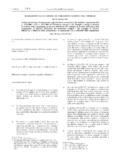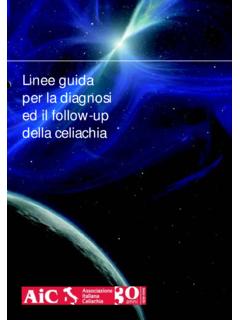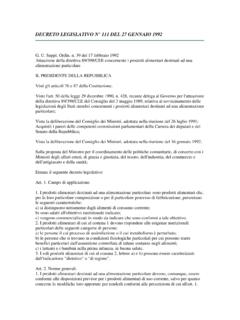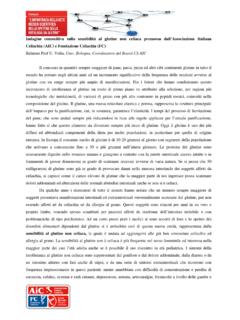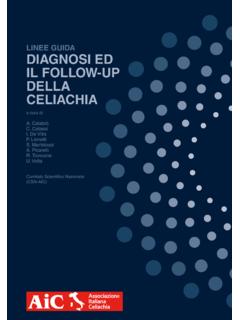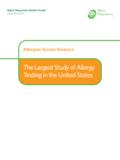Transcription of New ESPGHAN guidelines for the diagnosis of …
1 New ESPGHAN guidelines for the diagnosis of Coeliac disease in children and AdolescentsSteffen HusbyHans Christian Andersen children s Hospital Odense University Hospital, DenmarkAgenda Change in clinical paradigm Definitions of coeliac disease New diagnostic guidelines Algorithms Interlaken ESPGHAN criteria (1979) intestinal biopsy: villous atrophy free diet for 1-2 : normal. of gluten : villous atrophy McNeish et al. Arch Dis Childh 1979;54:783 Revised ESPGHAN criteria intestinal biopsy: villous and serological improvement after 2-3 months No further biopsy Provided age > 2 yearsWalker Smith et al. Arch Dis Child 1990;65:99 General:Puberty & growth delayMalignanciesAnemiaGI system:Diarrhea, vomitingDistension, painMalnutrition, weight lossHepatitis, cholangitisBone:Osteoporosis, fracturesArthritisDental anomaliesCNS:Ataxia, seizuresDepressionHeart:CarditisSkin & mucosa:Dermatitis herpetiformisAphtous stomatitisHair lossReproductive system:MiscarriageInfertilityModified fromRewers, Gastroenterology 2005 Celiac disease as a multiorgan autoimmune diseaseCoeliac diseaseType 1 DiabetesDermatitis herpetiformisAutoimmune hypothyroidismAdrenal antibodiesHansen et al.
2 UnpublishedPatientTowards a new definition of coeliac disease Chronic Multi-organ Small intestinal inflammation Transglutaminase-relatedESPGHAN working group, 2011 Suggestion: New definition an immune-mediated systemic disorder elicited by gluten and related prolamines in genetically (mainly HLA) susceptible individuals characterized by a combination of: gluten dependent clinical manifestations anti-tissue transglutaminase (TG2) antibodies enteropathy Husby et al. JPGN 2012 ESPGHAN classification Silent CD:positive CD antibodies and biopsy findings, not sufficient symptoms to warrant clinical suspicion of CD Latent CD: positive CD antibodies, no villous atrophy. The patient has had a gluten-dependent enteropathy. Patient may/may not have symptoms Potential CD: positive antibodies, but no villous atrophy. Patient may/may not have symptoms. CD may or may not developThe Oslo Definitions Coeliac disease is a chronic small intestinal immune-mediated enteropathy precipitated by exposure to dietary gluten in genetically predisposed individuals.
3 Discourage the use of classical vs. non-classical, typical vs. atypical Discourage the use of the term latent CDLudvigsson et al. Gut 201285 % of those who are compliant to the 1990 criteria want them to be changed challenge policy: 100 % HLA should be included for DX 80%ESGPHAN member et al. JPGN 2012 Previous evidence-based guidelines for CD diagnosis AHRQ (USA, 2004) Adults and children NICE guidelines (UK, 2009) Adults and children For GP s and general paediatricians None questioned the biopsyRostom A, et Celiac disease . EvidenceReport/ Technology Assessment No. 104. AHRQ Publication No. 04-E029-2, 2004 NICE Clinical guidelines 86. Coeliac disease : Recognition and assessment of coeliac disease . UK, May 2009 guidelines : AHRQ (USA, 2004) of serological / incidence of CD associated of testing for for adherence to a gluten-free and specificity of EMA and TG2 ab quite common, prevalence in the general population likely close to 1 in coeliac societies improves compliance with a GFDR ostom A, et Celiac disease .
4 EvidenceReport/Technology Assessment No. 104. AHRQ Publication No. 04 E029 2, 2004 Main issuesConclusionsEvidence-based criteria for clinical an answerable down the best evidence appraise the evidence for Validity Impact (size of the benefit) with clinical expertise and patient our effectiveness and efficiency keep a record/improve the processEvidence-based medicinePatient preferencesand valuesDevereaux 2004 Clinical circumstancesLiterature searchSearch 1: n=1,418 EMBASE, 2: n= 3: n=778 Embase ,598 Entering Level 1 screeningn=2,242 + 22 no full textexcludedn=334 Full textEntering Level 2 screeningn=247excludedn=87 Entering Level 3 screeningn = 16 publicationsIncluded in data synthesisN = 71 excluded based on E1-8:No biopsyAgeQuality et al. 2010 Grading EvidenceType of study: DiagnosisStudy QualityLevel 1: Good quality patient-oriented evidence Validated clinical decision rule Systematic Review(SR)/meta-analysis of high quality studies High quality diagnostic cohort studyLevel 2: Limited quality patient-oriented evidence Unvalidated clinical decision rule SR/meta-analysis of lower qualitystudies or studies Lower quality diagnostic cohort studyor diagnostic case control studyLevel 3: Other evidenceConsensus guidelines , extrapolations from bench research, usual practice, opinion, disease -oriented evidence, case series MH et al.
5 JABFP 2004 Example statement: Increased prevalence of CD in children with Type 1 diabetes 2 12 Down s syndrome 5-12 Autoimmune thyroid disease up to 7 Turner syndrome 2-5 Williams syndrome up to 9 IgA deficiency 2-8 Autoimmune liver disease 12-13 First degree relatives with CD 10-20%Recommendation: ( ) offer testing for CD of children and adolescents with the following conditions: Type 1 diabetes Down s syndrome Autoimmune thyroid disease Turner syndrome Williams syndrome IgA deficiency Autoimmune liver disease 1st degree relatives with CDCoeliac Antibodies IgA Anti-TG2 antibody IgA Endomysial antibody (EMA) IgA and IgG Deamidated Gliadin Peptide (DPG) antibody NOT: IgA and IgG anti-gliadin antibodiesDISEASE PREDICTION BY ANTIBODIES(pooled estimates with 95% confidence values; indicates high hetereog neity)Positive likelihood ratioNegative likelihood ratioOdd sratioEMA ( ) ( )553(218-1402)Anti-TG2 ( ) ( )469 (250-880)Anti-DGP ( ) ( )234(100-546)Anti-DGP ( ) ( ) (56-132)AGA ( ) ( ) (14-117)Giersiepen, Evidence report, JPGN 20121994200136543644 Diagnosedceliac: 010361727M ki, N Engl J Med 20031 of symptomatic coeliac disease in EMA positive subjectsPredictive values for TG2 antibodyPositive predict.
6 ValueToftedal et al. JCLM 201010100100010203040 Aesku 135 Site Luminex 43 DiaSorin 57 Euroimmun 200 * 95 Assays 89 69 * ELIA ImmunoCAP Varelisa in Varelisa [Celikey]Median ELISA values in 14 commercial anti-TG2 assays(data kindly provided by UK NEQAS)AU High sample xULN*logarithmic assaysChild / adolescent with Symptoms suggestive of CDAnti-TG2 IgA & total IgA*Anti-TG2positiveNot CDTransfer to Paediatric GIPaed. GI discusses with family the 2 diagnostic pathways and consequences considering patient s history & anti-TG2 titersConsider further diagnostic testing if:IgA deficiencyAge: < 2 yearsHistory: - low gluten intake- drug pretreatment- severe symptoms- associated diseasesAnti-TG2 > 10 x normalAnti-TG2 < 10 x normalEMA & HLA DQ8/DQ2 EMA availableOEGD & biopsiesAnti-TG2negativeEMA 0-1 Marsh 2 or 3 Consider false neg.
7 HLA test. Consider biopsiesUnclear caseConsider: false pos. serologyfalse neg. biopsy or potential CDConsider false pos. anti-TG2CD+CD+EMA 0-1 Marsh 2 or 3 Consider false neg. HLA test. Consider biopsiesUnclear caseConsider: false pos. serologyfalse neg. biopsy or potential CDExtended evaluation of HLA/serology/biopsiesConsider false pos. anti-TG2CD+GFD& F/uCD+GFD& F/uChild / adolescent with Symptoms suggestive of CDAnti-TG2 IgA & total IgA*Anti-TG2positiveNot CDTransfer to Paediatric GIPaed. GI discusses with family the 2 diagnostic pathways and consequences considering patient s history & anti-TG2 titersConsider further diagnostic testing if:IgA deficiencyAge: < 2 yearsHistory: - low gluten intake- drug pretreatment- severe symptoms- associated diseasesAnti-TG2 > 10 x normalAnti-TG2 < 10 x normalEMA & HLA DQ8/DQ2 Not availableOEGD & biopsiesAnti-TG2negativeChild / adolescent with Symptoms Suggestive of CDAnti TG2 & total IgA* Anti TG2positiveNot CDTransfer to Paediatric GastroenterologistPaed.
8 GI discusses with family the 2 diagnostic pathways and consequences considering patient s history & anti TG2 titers-Consider further diagnostic testing if:IgA deficientAge: < 2 yearsHistory: low gluten intake drug pretreatment severe symptoms associated diseasesPositive Anti TG2>10xnormal EMA & HLA testing for DQ2/DQ8 EMA availableOEGD & biopsiesAnti TG2negativeEMA 0 1 Marsh2or3 Consider falseneg. HLA testConsider biopsies Unclear caseConsider:false pos. serologyfalse neg. biopsy orpotential CDExtended evaluation ofHLA/serology/biopsiesConsider falsepos. Anti TG2 CD+GFD& F/uCD+GFD& F/u**or specific IgG based testsPositive Anti TG2<10xnormal Rationale for omitting biopsiesin selected cases Serological tests improved over last years Histology not as perfect as thought 20 yrs ago (lower sensitivity and specificity than serology) Risk-benefit ratio has changed: risk and cost of invasive procedure (OEGD, histological work-up) versus risk of false positive diagnosisEMAM arsh 0-1 Marsh 2 or 3*Or specific IgG based testsEMA positiveEMA negativeOEGD & biopsiesFrom bulbus & 4 pars descendens, proper histological work upCD+GFD& F/uUnclear caseF/u on normal diet.
9 Consider:False pos. serology, false neg. biopsy or potential CDConsider:Transient/false pos. anti-TG2F/u on normal diet with furtherserological testingConsider:False neg. Results, exclude IgA deficiency and history of low gluten intake or drugsAsymptomatic person at genetic risk for CDExplain implication of positive test result(s) and get consent for testningHLA DQ2 / DQ8 (+/- TG2)HLA positiveDQ2 and/or DQ8No CD,no risk for CDTG2 & total IgA*Consider retesting in intervals or if symptomaticTiter > 3 x normalHLA negativeDQ2 and/or DQ8 Titer < 3 x normalTG2 negativeNot CD*Or specific IgG based testsCD+GFD& F/uUnclear caseF/u on normal diet. Consider:False pos. serology, false neg. biopsy or potential CDConsider:Transient/false pos. anti-TG2F/u on normal diet with furtherserological testingAsymptomatic person at genetic risk for CDExplain implication of positive test result(s) and get consent for testningHLA DQ2 / DQ8 (+/- TG2)HLA positiveDQ2 and/or DQ8 Not CD,no risk for CDTG2 & total IgA*Consider retesting in intervals or if symptomaticTiter > 3 x normalEMAM arsh 0-1 Marsh 2 or 3 HLA negativeDQ2 and/or DQ8 Titer < 3 x normalTG2 negativeNot CDEMA positiveEMA negativeOEGD & biopsiesFrom bulbus & 4 pars descendens, proper histological work upConsider:False neg.
10 Results, exclude IgA deficiency and history of low gluten intake or drugsAsymptomatic Person at Genetic Risk for CDExplain implication of positive test result(s) and get consent for testingHLA DQ testing (+/ Anti TG2)HLA positive forDQ2 and/or DQ8 Not CD,no risk for CDAnti TG2 & total IgA*Consider retesting in intervals or if symptomaticEMAM arsh 0 1-Marsh 2 or 3**or specific IgG based testsHLA negative forDQ2 and/or DQ8 Positive Anti TG2 < 3x normalAnti TG2 negativeNot CDEMA positiveEMA negativeOEGD & biopsies: 1 x bulbus & 4 x pars descendens, proper histological work up CD+GFD& F/uUnclear caseF/u on normal diet Consider: false pos. serology, false neg. biopsy or potential CDConsider: age, false neg. results, exclude IgA deficiency and history of low gluten intake or drugs Positive Anti TG2 >3x normalConsider: Transient / false pos. anti TG2F/u on normal diet with further serological testing Why different algorithms for symptomatic and asymptomatic (at risk) patients?
